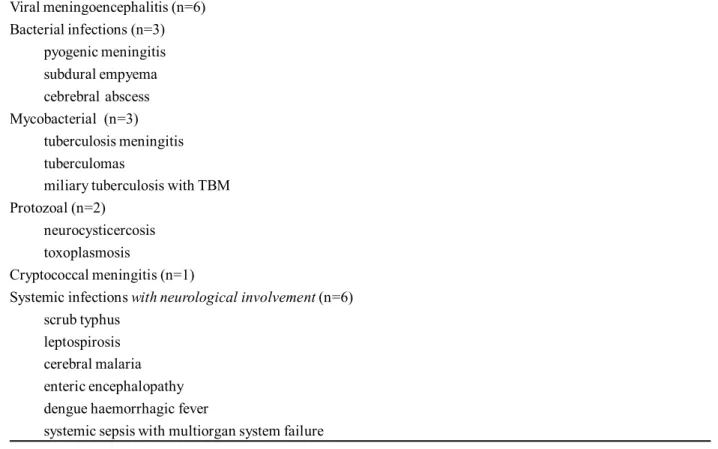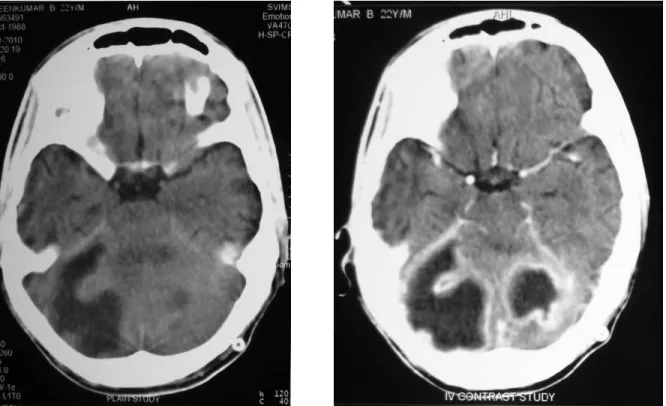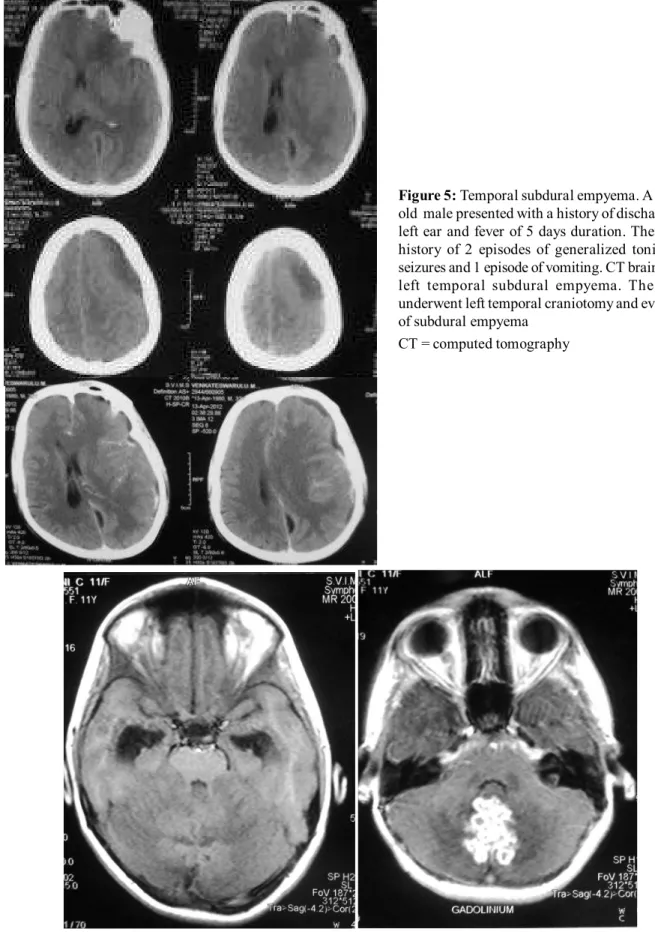Received: 04 August, 2013.
INTRODUCTION
Neurological intensive care is an emerging speciality globally. In developing countries like India, however, facilities for intensive care are not widely available.1 Further, very few centres,
such as, tertiary care teaching hospitals attached to medical colleges, and some of the corporate sector hospitals in the country have facilities for neurological intensive care. The recent emergence of multidrug-resistant pathogens has added to the complexity of the management of central nervous system (CNS) infections. In this review an attempt has been made to provide an overview regarding the methodological issues, burden of the problem, diagnostic approach and key principles underlying the management of neurological infections requiring admission to the ICU.
Central nervous system infections in ICU patients
Neurological infections can be encountered in ICU patients in the following situations. (i) CNS infections constitute an uncommon, but important aetio logical cause requiring admission to an intensive care unit (ICU). In additio n, (ii) health-care asso ciat ed neurolo gical infect ions may develop in critically ill patients admitted to an ICU for other indications. Furthermore, (iii) CNS infections can develop as complications in ICU patients including post-operative neurosurgical patients.2
Burden of the problem
Indian scenario
Sparse published data are available on the spectrum of neurological infections requiring
Review Article:
Central nervous system infections in the intensive care unit
B. Vengamma,1 M. Rajguru,1 B.C.M. Prasad,2 V.V. Ramesh Chandra2
Departments of 1Neurology, 2Neurosurgery, Sri Venkateswara Institute of Medical Sciences, Tirupati
ABSTRACT
Neurological infections constitute an uncommon, but important aetiological cause requiring admission to an intensive care unit (ICU). In addition, health-care associated neurological infections may develop in critically ill patients admitted to an ICU for other indications. Central nervous system infections can develop as complications in ICU patients including post-operative neurosurgical patients. While bacterial infections are the most common cause, mycobacterial and fungal infections are also frequently encountered. Delay in institution of specific treatment is considered to be the single most important poor prognostic factor. Empirical antibiotic therapy must be initiated while awaiting specific culture and sensitivity results. Choice of empirical antimicrobial therapy should take into consideration the most likely pathogens involved, locally prevalent drug-resistance patterns, underlying predisposing, co-morbid conditions, and other factors, such as age, immune status. Further, the antibiotic should adequately penetrate the blood-brain and blood- cerebrospinal fluid barriers. The presence of a focal collection of pus warrants immediate surgical drainage. Following strict aseptic precautions during surgery, hand-hygiene and care of catheters, devices constitute important preventive measures. A high index of clinical suspicion and aggressive efforts at identification of aetiological cause and early institution of specific treatment in patients with neurological infections can be life saving.
Key words:Central nervous system infections, Intensive care unit, Meningitis, Ventriculitis
Vengamma B, Rajguru M, Prasad BCM, Ramesh Chandra VV. Central nervous system infections in the intensive care unit. J Clin Sci Res 2014;3:106-13. DOI: http://dx.doi.org/10.15380/2277-5706.JCSR.13.044.
Corresponding author: Dr B. Vengamma, Dir ector, Sen ior Pr ofessor an d Head, Department of Neurology, Sri Venkateswara Institute of Medical Sciences, Tirupati, India. e-mail: bvengamma@yahoo.com
Online access
http://svimstpt.ap.nic.in/jcsr/apr- jun 14_files/1ra214.pdf
ICU admission especially from India. Furthermore, many of the critically ill patients with neurological infections variably get admitted to the medical, neurological or respiratory ICUs depending on the availability and prevailing admission policy. The variability and flexibility of policy for admitting patients with neurological infections into ICUs should be kept in mind while interpreting these data.
CNS infections requiring admission into an ICU
In publication dating back to more than two decades ago2 CNS infections constituted 2.3%
to 10.5% of admissions into medical, surgical and critical care ICUs in India. In another report,2 neurological infections constituted 51%
of admissions to a neurological ICU in South India. At a teaching hospital at Hyderabad, CNS infections had accounted for 17% of admissions to a neurological ICUs.3
Coma is a common indication for admission to an ICU. In the Indian scenario CNS
infections constitute an important cause of coma. In published studies from India4,5
neurological infections accounted for 20% to 57% of aetiological causes in coma patients needing admission to an ICU.
At our tertiary care teaching hospital, neurological infections accounted for 8.7% of all ICU admissions (n=252) seen during the six month period (Dec 2012 to May 2013) in the medical ICU. The spectrum of patients with neurological infections requiring admission to ICU at Sri Venkateswara Institute of Medical Sciences (SVIMS), Tirupati a tertiary care teaching hospital is shown in Table 1.
CNS infections developing as complications in ICU patients
Reliable epidemiological data regarding the true prevalence of health care-associated intracranial infectious complications are not available. Sparse published data refer to post neuro-surgical infectious complications and
Table 1: Spectrum of neurological infections requiring admission to medical intensive care unit at Sri Venkateswara Institute of Medical Sciences, Tirupati during a six-month period (Dec 2012 to May 2013)
Viral meningoencephalitis (n=6) Bacterial infections (n=3)
pyogenic meningitis subdural empyema cebrebral abscess Mycobacterial (n=3)
tuberculosis meningitis tuberculomas
miliary tuberculosis with TBM Protozoal (n=2)
neurocysticercosis toxoplasmosis
Cryptococcal meningitis (n=1)
Systemic infections with neurological involvement (n=6) scrub typhus
leptospirosis cerebral malaria enteric encephalopathy dengue haemorrhagic fever
CNS infections secondary to traumatic brain injury. The following conditions have been considered to be important risk factors for health-care associated CNS infections: history of neurosurgery; CSF leakage; recent head trauma; presence of an evident focus of infection; and an immunocompromised state. Patients with aneurysmal subarachnoid hemorrhage or severe traumatic brain injury receiving neurocritical care, especially, are considered to be at high risk for infections arising at distant foci, such as, endocarditis, blood stream infections, pneumonia, urinary tract infections, among others. In patients undergoing invasive procedures, such as, craniotomy, intracranial device placement [for e.g., for intracranial pressure (ICP) monitoring, or diversion of the cerebrospinal fluid (CSF) from an obstructed ventricular system], health-care associated CNS infections (Table 2) have been known to develop.6 As per the National
Healthcare Safety Network, Division of Healthcare Quality Promotion, Centers for Disease Control and Prevention (CDC/NHSN)6
definition of CNS infection, intracranial infection must satisfy at least one of the criteria listed in Table 3. At least one of the criteria listed in Table 4 must be satisfied for diagnosing meningitis or ventriculitis.6
Septic thrombosis of cerebral sinus and/or veins is another documented cause of CNS infection in ICU patients. Also, neuroinfections may arise from more ‘exogenous’ sources such as transmission of pathogens from ICU personnel or the ICU environment; poor hand hygiene has been identified to be one of the common and important causes of health-care associated infections in ICU patients.
CNS infection Vs catheter colonization/ contamination
In critically ill ICU patients, it is important to distinguish CNS infections from catheter
Table 3: Criteria for the diagnosis of definition of CNS infection (intracranial infections)
1. Patient has organisms cultured from brain tissue or dura
2. Patient has an abscess or evidence of intracranial infection seen during a surgical operation or on histopathologic examination
3. Patient has at least two of the following signs or symptoms with no other recognized cause: headache, dizziness, fever (>38 oC), localizing neurologic signs, changing level of consciousness, or confusion, and at least one of the following:
a. organisms seen on microscopic examination of brain or abscess tissue obtained by needle aspiration or by biopsy during a surgical operation or autopsy
b. positive antigen test on blood or urine c. radiographic evidence of infection, and
d. diagnostic single antibody titer (IgM) or four-fold increase in paired sera (IgG) for pathogen; and if diagnosis is made antemortem, physician institutes appropriate antimicrobial therapy
CNS = central nervous system; Ig = immunoglobulin
Source: reference 6
Table 2: Commonly encountered health-care associated central nervous system infections in ICU patients
Intracranial infections brain abscess
subdural or epidural infection encephalitis
Meningitis or ventriculitis Spinal abscess without meningitis
ICU = intensive care unit
colonization and contamination. In this scenario, a positive CSF culture in the absence of abnormal CSF findings is suggestive of “contamination”; occurrence of at least two positive CSF cultures with expected CSF profiles and lack of clinical signs is suggestive of “cat heter colonization”.6,7 Further,
pathological CSF findings in the absence of positive cultures is suggestive of device-related infection; and a po sitive CSF culture accompanied by abnormal CSF findings or appropriate clinical scenario is suggestive of hospital acquired meningitis. It is also important to distinguish CNS infection from aseptic inflammatio n that o ccurs as a consequence of tissue response to tissue injury or stimulation by noninfectious agents.
CNS manifestations of systemic infections in ICU patients
Recent trends have indicated that in addition to severe complicated falciparum malaria, enteric fever, systemic infections, such as, leptospirosis, scrub typhus are emerging as important causes for infections with CNS involvement needing ICU admission.
Diagnostic approach
A thorough clinical history and a meticulously conducted physical examination often provide valuable diagnostic clues to the aetiological cause of CNS infections in critically ill patients. Occurrence of fever and deterioration in the level o f sensorium; evidence of raised
intracranial pressure in a comatose or sedated patient are important early clues suggestive of CNS infection and should alert the clinicians. A history of residence or travel from a malaria endemic area (malaria), occupations like farmers working in paddy fields, sewerage workers (leptospirosis) can help in diagnostic work-up. In patients with altered sensorium, a history of prolonged fever with loose stools, gastrointestinal bleeding may raise the possibility of enteric fever. Fever, headache, photophobia and vomiting may point to meningitis. General physical examination clues, such as, eschar (scrub typhus), peticheal rash (dengue fever, falciparum malaria, scrub typhus, leptopsirosis), subcutaneous nodules (neurocysticercosis), presence of hepatic dysfunction and /or acute kidney injury (falciparum malaria, leptopsirosis) may be helpful in identifying infections. While fever is often present in critically ill patients with neurological infections, some patients with life-threatening neurological infections can present without fever.8 Fundus examination after
mydriatic administration can help in identifying choroid tubercles which are pathognomonic of miliary tuberculosis.9 Presence of
lymphadeno-pathy, pleural effusion or ascites may point out to disseminated tuberculosis, especially in human immunodeficiency virus (HIV) seropositive individuals.10 Neurolo gical
examination may reveal neck stiffness and other signs of meningeal irritation or focal neuro-logical deficit.
Table 4: Criteria for the diagnosis of definition of CNS infection (meningitis or ventriculitis)
1. Patient has organisms cultured from CSF
2. Patient has at least one of the following signs or symptoms with no other recognized cause: fever (>38 oC), headache, stiff neck, meningeal signs, cranial nerve signs, or irritability and at least one of the following: a. increased white cells, elevated protein, and/or decreased glucose in CSF
b. organisms seen on Gram’s stain of CSF c. organisms cultured from blood
d. positive antigen test of CSF, blood, or urine, and
e. diagnostic single antibody titer (IgM) or four-fold increase in paired sera (IgG) for pathogen; and if diagnosis is made antemortem, physician institutes appropriate antimicrobial therapy
CNS = central nervous system; CSF = cerebrospinal fluid; Ig = immunoglobulin
Tuberculosis meningitis (TBM) accounts for more than 70% of cases of neurological tuberculosis (TB) and is a great mimic. In spite of TBM being a commonly encountered disease and widespread physician awareness, there is often a delay in the diagnosis and institution of specific therapy for TBM. This is particularly true in the ICU setting.9,10 Fungal meningitis
is an uncommon but important CNS infections seen in the ICU. Clinical presentation of fungal infections may range from acute fulminant forms to chronic indolent forms causing significant morbidity and mortality. Low index of suspicion, atypical presentation, and variable neuroradiologic findings result in a delayed diagnosis of this condition. Fungal CNS infections should be suspected in patients with poo rly cont rolled diabetes and immunosuppressed patients. Common fungal infections of CNS seen in the ICU include
Cryptococcus meningitis (especially in
HIV-positive patients), Mucormycosis (e.g.,
rhinocerebral mucormyco-sis), Aspergillosis,
Scedosporium, Candida among others.2
Anthrax is a zoonotic disease which has recently been used as a weapon of bioterrorism. It is a rare but catastrophic cause of haemorr-hagic meningoencephalitis. The diagnosis is established by Gram stain of CSF smear examination.11 Fungal meningit is, viral
meningitis and even TBM require extensive laboratory facilities for confirmation of aetiological diagnosis. However, these facilities are seldom available in India and most of these patients get treated empirically.
Imaging and laboratory diagnosis
Neuroimaging and CSF analysis constitute key investigations in establishing the diagnosis of CNS infection in critically ill pat ient s. However, CSF examination may not always be possible in critically ill patients due to the presence of increased intracranial pressure, thrombocytopenia, bleeding tendency, among
Figure 1: Cerebellar abscess. A 22-year-old male presented with headache, vomitings and fever of 1 week duration. There was a history of decreased hearing left side associated with ear discharge. Plain (A) and contrast-enhanced (B) CT of the brain showed cerebellar abscess with hydrocephalus. The patient underwent suboccipital craniectomy and evacuation of cerebellar abscess
Figure 2: Right-sided frontal abscess. A 23-year-old male pr esen ted with headache, fever, altered sensorium of 1 week duration. Plain (A) and contrast enhanced (B) CT brain right frontal abscess. The patient underwent right frontal craniotomy and excision of abscess
CT = computed tomography
Figure 3: Left-sided tempor al abscess. A 49-year-old male presented with fever, headache of 15 days and altered sensorium of 1 day duration. MRI brain showed left tempor al abscess. Th e patien t un der went left tempor opar ietal craniotomy and excision of abscess MRI = magnetic resonance imaging
Figure 5: Temporal subdural empyema. A 32-year-old male presented with a history of discharge from left ear and fever of 5 days duration. There was a history of 2 episodes of generalized tonic clonic seizures and 1 episode of vomiting. CT brain showed left temporal subdural empyema. The patient underwent left temporal craniotomy and evacuation of subdural empyema
CT = computed tomography
others and this may hamper the diagnostic work-up.
Imaging modalities like ultrasonography, computed to mography (CT), magnetic resonance imaging (MRI) can help in anatomical localization o f the fo cus of infection (Figures 1,2,3,4,5 and 6). Identifica-tion of aetiological cause of neurological infection requires lumbar punct ure and cerebro spinal fluid examination by biochemical, microbiological and molecular diagnostic methods; blood culture and culture of urine, pleural, ascitic and other body fluids. Serodiagnostic and molecular tests for dengue fever, leptospirosis and scrub typhus infections must be carried out.
Fungal, viral meningitis and even TBM require extensive laboratory facilities for confirmation of aetiological diagnosis. However, these facilities are seldom available in India and most of these patients get treated empirically.
Principles of management
In patients admitted to the ICU, monitoring is carried out by noninvasive and if required, invasive methods. Care should be taken regarding fluid, electrolyte and nutritional management. A detailed description of the various therapeutic regimens available for treatment of neurological infections is beyond the scope of this review.
A high index of clinical suspicion and aggressive efforts at identificat ion of aetiological cause and early institution of specific treatment in patients with neurological infections can be life saving. Delay in institu-tion of specific treatment (e.g., antibiotic treatment) is considered to be the single most important poor prognostic factor. Empirical antibiotic therapy must be initiated while awaiting specific culture and sensitivity results. Choice of empirical antimicrobial therapy should take into consideration the most likely pathogens involved, locally prevalent drug-resistance patterns, underlying predisposing,
co-morbid conditions, and other factors, such as age, immune status. Further, the antibiotic should adequately penetrate the blood-brain and blood-CSF barriers. The presence of a focal collection of pus warrants immediate surgical drainage. Following strict aseptic precautions during surgery, hand-hygiene and care of cathet ers, devices co nstitute important preventive measures.
REFERENCES
1. Mohan A, Bollineni S. Predicting mortality in critically ill obstetric patients requiring intensive care unit admission in India. Indian J Med Sci. 2007;61:175-7.
2. Beer R, Pfausler B, Schmutzhard E. Infectious intracranial complications in the neuro-ICU patient population. Curr Opin Crit Care 2010;16:117-22. 3. Udwadia FE, Guntupalli KK, Vidyasagar D. Critical care in India. Crit Care Clin 1997;13:317-29.
4. Desai BT, Vijayaraghavan A. Neurologic intensive care in India. Natl Med J India 1991;4;162-5.
5. Meena AK, Prasad VS, Murthy JM. Neurological intensive care in India-disease spectrum and outcome. Neurol India 2001;49 Suppl 1:S1-7.
6. Horan TC, Andrus M, Dudeck MA. CDC/NHSN
surveillance definition of healthcare-associated infection an d criteria for specific types of infections in the acute care setting. Am J Infect Control 2008;36:309-32.
7. Lozier AP, Sciacca RR, Romagnoli MF, Connolly ES Jr. Ventriculostomy-related infections: a critical r eview of th e literatur e. Neur osurger y 2002;51:170-81; discussion 181-2.
8. Launey Y, Nesseler N, Mallédant Y, Seguin P. Clinical review: fever in septic ICU patients-friend or foe? Crit Care 2011;15:222.
9. Sharma SK, Mohan A, Sharma A. Challenges in the diagnosis & treatment of miliary tuberculosis. Indian J Med Res 2012;135:703-30.
10. Sharma SK, Mohan A. Tuberculosis: From an incurable scourge to a curable disease - journey over a millen n ium. In dian J Med Res 2013;137:455-93.



